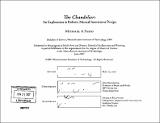| dc.contributor.advisor | Tod Machover. | en_US |
| dc.contributor.author | Fabio, Michael A., S.M. Massachusetts Institute of Technology | en_US |
| dc.contributor.other | Massachusetts Institute of Technology. Dept. of Architecture. Program In Media Arts and Sciences | en_US |
| dc.date.accessioned | 2007-10-22T17:38:57Z | |
| dc.date.available | 2007-10-22T17:38:57Z | |
| dc.date.copyright | 2007 | en_US |
| dc.date.issued | 2007 | en_US |
| dc.identifier.uri | http://hdl.handle.net/1721.1/39342 | |
| dc.description | Thesis (S.M.)--Massachusetts Institute of Technology, School of Architecture and Planning, Program in Media Arts and Sciences, 2007. | en_US |
| dc.description | Includes bibliographical references (leaves 169-173). | en_US |
| dc.description.abstract | This thesis presents several works involving robotic musical instruments. Robots have long been used in industry for performing repetitive tasks, or jobs requiring superhuman strength. However, more recently robots have found a niche as musical instruments. The works presented here attempt to address the musicality of these instruments, their use in various settings, and the relationship of a robotic instrument to its human player in terms of mapping and translating gesture to sound. The primary project, The Chandelier, addresses both hardware and software issues, and builds directly from experience with two other works, The Marshall Field's Flower Show and Jeux Deux. The Marshall Field's Flower Show is an installation for several novel musical instruments and controllers. Presented here is a controller and mapping system for a Yamaha Disklavier player piano that allows for real-time manipulation of musical variations on famous compositions. The work is presented in the context of the exhibit, but also discussed in terms of its underlying software and technology. Jeux Deux is a concerto for hyperpiano, orchestra, and live computer graphics. | en_US |
| dc.description.abstract | (cont.) The software and mapping schema for this piece are presented in this thesis as a novel method for live interaction, in which a human player duets with a computer controlled player piano. Results are presented in the context of live performance. The Chandelier is the culmination of these past works, and presents a full-scale prototype of a new robotic instrument. This instrument explores design methodology, interaction, and the relationship-and disconnect-of a human player controlling a robotic instrument. The design of hardware and software, and some mapping schema are discussed and analyzed in terms of playability, musicality, and use in public installation and individual performance. Finally, a proof-of-concept laser harp is presented as a low-cost alternative musical controller. This controller is easily constructed from off-the-shelf parts. It is analyzed in terms of its sensing abilities and playability. | en_US |
| dc.description.statementofresponsibility | Michael A. Fabio. | en_US |
| dc.format.extent | 174 leaves | en_US |
| dc.language.iso | eng | en_US |
| dc.publisher | Massachusetts Institute of Technology | en_US |
| dc.rights | M.I.T. theses are protected by copyright. They may be viewed from this source for any purpose, but reproduction or distribution in any format is prohibited without written permission. See provided URL for inquiries about permission. | en_US |
| dc.rights.uri | http://dspace.mit.edu/handle/1721.1/7582 | |
| dc.subject | Architecture. Program In Media Arts and Sciences | en_US |
| dc.title | The chandelier : an exploration in robotic musical instrument design | en_US |
| dc.title.alternative | Exploration in robotic musical instrument design | en_US |
| dc.type | Thesis | en_US |
| dc.description.degree | S.M. | en_US |
| dc.contributor.department | Program in Media Arts and Sciences (Massachusetts Institute of Technology) | |
| dc.identifier.oclc | 173610628 | en_US |
